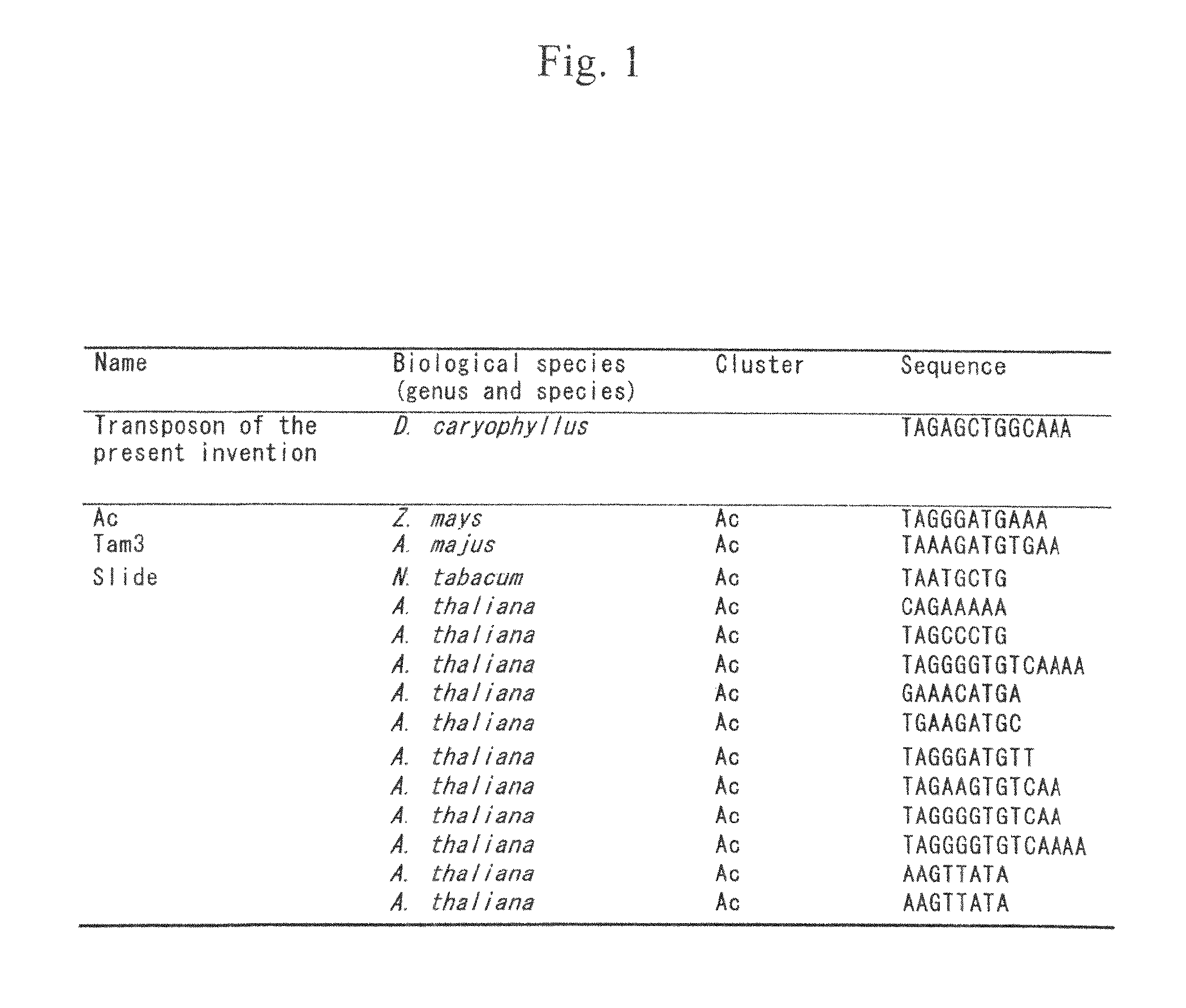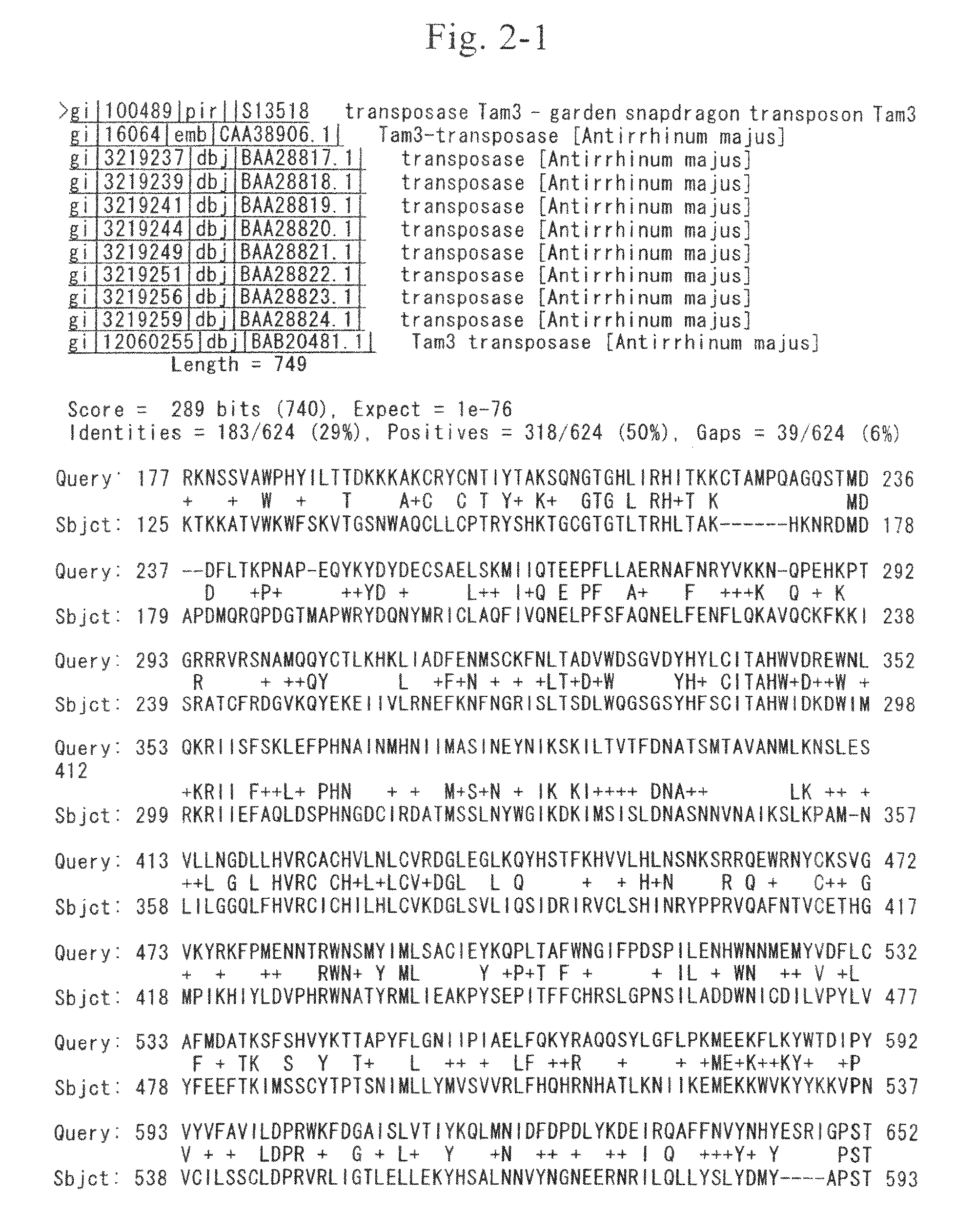Method for detecting mutation and a method for inducing mutation
a mutation and mutation technology, applied in the field of methods for detecting mutations, can solve the problems of high labor intensity, low efficiency, and inability to observe the analogous properties of an internal nucleotide sequence of approximately 4 kb, and achieve the effect of low efficiency
- Summary
- Abstract
- Description
- Claims
- Application Information
AI Technical Summary
Benefits of technology
Problems solved by technology
Method used
Image
Examples
example 1
Analysis of Carnation Petal Pigments
[0107]Carnation petal pigments were analyzed according to the method of Masaatsu Yamaguchi (MINAMI KYUSHU UNIVERSITY Bulletin of the Faculty of Horticulture (1988), Vol. 19, pp. 1-78: Basic Studies on the flower color breeding of Carnations (Dianthus caryophyllus L.)). Petals from carnation clones 95SP and 97SPi were each subjected to extraction with 5% acetic acid and 50% ethanol, followed by development with TLC (acetic acid:hydrochloric acid:water=15:3:82). These development images were compared with an image of an extract from carnation petals (variety: Barbara (Hilverda Plant Technology)) having a known pelargonidin 3 glucoside 5 glucoside (Pg3G5G) pigment and compared with an image of an extract from carnation petals (variety: Lilac (SIRI BROTHERS NURSERY, INC.)) having a cyanidin 3 glucoside 5 glucoside(Cy3G5G) pigment. Thus, it could be inferred that 95SP mainly contained a pigment having the cyanidin backbone and 97SPi contained a pigment...
example 2
Preparation of Carnation Genomic DNA
[0108]The DNAs of carnation clones 95SP, 97SPi, 97SE, 99SP5, and 99SP4 were prepared using in vitro leaf sections as materials by Nucleon PhytoPure (Amersham) according to attached protocols.
[0109]In addition, 99SP5 and 99SP4 were obtained by the following techniques and then used as materials. 1000 in vitro plants with a height of approximately 5 cm were subjected to X-ray irradiation with a dose of 4 KR according to a standard method. The plants were acclimatized in a greenhouse. Axillary buds were collected and grown. Axillary buds were collected again from plants that had developed roots and then the buds were grown. Such steps were repeated several times. As a result, two plants (99SP5 and 99SP4) developing pink flowers (plants developing the same flower color as developed by 97SPi) were obtained.
example 3
Preparation of Carnation cDNA
[0110]Carnation clone 95SP RNA was prepared according to the method described in Cell Engineering, Separate Volume, Plant Cell Engineering Series 2, Plant PCR Experimental Protocols (1995) 42-43. Then, the cDNA was prepared using RNA isolated from petals by a cDNA synthesis kit (TAKARA BIO INC.) with a 18-nucleotide-long dT primer attached to the kit according to the attached protocols.
PUM
| Property | Measurement | Unit |
|---|---|---|
| temperature | aaaaa | aaaaa |
| temperature | aaaaa | aaaaa |
| temperature | aaaaa | aaaaa |
Abstract
Description
Claims
Application Information
 Login to View More
Login to View More - R&D
- Intellectual Property
- Life Sciences
- Materials
- Tech Scout
- Unparalleled Data Quality
- Higher Quality Content
- 60% Fewer Hallucinations
Browse by: Latest US Patents, China's latest patents, Technical Efficacy Thesaurus, Application Domain, Technology Topic, Popular Technical Reports.
© 2025 PatSnap. All rights reserved.Legal|Privacy policy|Modern Slavery Act Transparency Statement|Sitemap|About US| Contact US: help@patsnap.com



